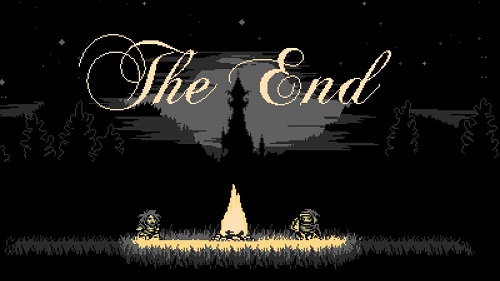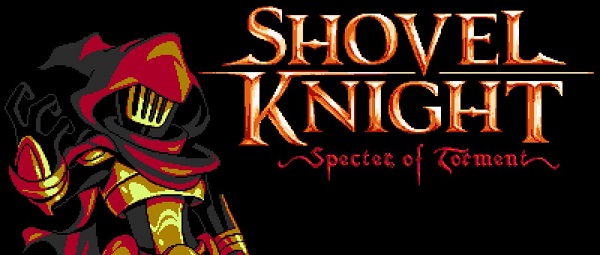
One of the Switch’s launch games was a timed exclusive of the next hotly anticipated DLC expansion for Shovel Knight: the new Specter of Torment campaign. While I did get constant development update emails because I was a Kickstarter backer, I decided to ignore them for the most part, and went into this one almost completely blind.
To set up the story: Shovel Knight is right up there on my list of favourite games of all time. I loved it to pieces when it launched in 2014 and have played it routinely every few months since then. The first expansion was Plague of Shadows, which released in September of 2015. It added a entirely new story that ran parallel to the original, and Plague Knight had a completely different play style, making the game feel totally fresh even though it was mostly the same, save a few small new areas and a new final boss. Although it was a masterful expansion, it was still just that: an expansion.
Knowing basically nothing about it pre-release, I assumed that Specter of Torment would follow roughly the same rules: play through the same stages with a handful of new rooms and the same old bosses, enjoy a few revised challenge stages to test Specter Knight’s unique abilities, and then a showdown with a new final boss. But I was wrong. I was oh-so wrong.
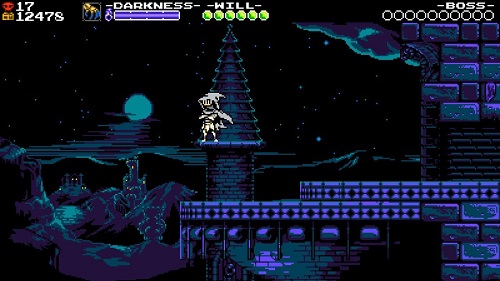
Specter of Torment, in reality, is more like the sequel to Shovel Knight that people have been clamouring for. Well, it’s actually a prequel, but that’s besides the point. It’s not 100% new content, but it’s probably pushing 90%, if not even more.
First off, and most notably, the flow of the game has changed radically. Gone is the world map, being replaced by a single hub stage where Specter Knight his pals chill between stages. The Tower of Fate’s lounge is fairly large and has plenty to do, including purchasing upgrades, chatting with all the Order Knights, and an absurdly difficult/fun mini-game. You’re given a simple stage select menu to go where you want, which lets you choose from any stage you want, rather than having them segmented into three sets like in Shovel Knight and Plague Knight’s campaigns.
The other thing that you’ll notice is that while all the stages have the same names, they are almost completely redesigned. There are similar screens here and there, but for the most part, they feel like entirely new stages. Even the backgrounds have been altered significantly, with tons of new scenery and unique stage gimmicks. The Lich Yard has you running through a spooky village instead of a graveyard. You have to make your way through a wooded area before actually reaching the Lost City proper. The Explodatorium now looks and feels like a much more intense version of Toad Man’s stage from Mega Man 4. And this is all with good reason, as Specter Knight plays much differently from the prior heroes, so his mechanics likely wouldn’t gel all that nicely with the old stage designs.
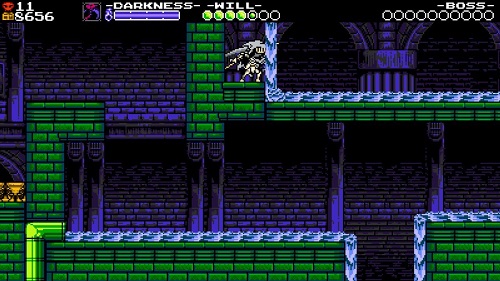
For starters, Specter Knight’s sprite is noticeably larger than either Shovel or Plague. This means that he’s a bit slower and can’t jump quite as high. Much to my surprise though, Specter Knight is a damn ninja. He can run up walls and do consecutive wall jumps to make up for the lack of vertical leap. His big gimmick, though, is the dash slash that he can perform whilst mid-air. Get close to an enemy or lantern, and attacking it will propel Speccy through the air either upwards or downwards, depending on his height relative to the target before the dash. You can chain up dash-slashes and wall-jumps to soar through stages with style and ease, and once you get the hang of it, you’ll quickly realize that Specter of Torment was almost certainly designed for speedrunners to tear apart.
To account for Specter Knight’s increased maneuverability, all of the bosses have gained extra-fancy new attack patterns. Some play out similarly at the start, beginning with an attack that you’ll be used to if you’ve played the previous games, and then segueing into a completely new fight. Other bosses have been rebuilt from the ground up, with Black Knight being the big standout, as he now rides a giant spiky turtle named Terrorpin into battle. The enhanced bosses were a great challenge to me, a Shovel Knight veteran, so I have a little concern that inexperienced played might find them unstoppable. Even the usually laughable Tinker Knight is now an absolute beast, that took me a number of tries to beat. Specter Knight also has a new rail-grinding move that is used roughly twice over the course of the game, one of those instances being against his unique final boss. The battle is completely on-rails, which seemed weird at first, but looking back, it added an extra sense of action and thrill to the fight. I think it was a good move.
As much as I enjoyed the new boss fights, it did make me wonder a little. If this is supposed to be a prequel, why are they so much weaker later on? Just an inevitable pitfall of using the same characters, I suppose. At least it’s a plot hole that we can just handwave away and forget about.
To go along with all this new content comes… all the old enemies. Yup, they’re all accounted for. Some mini-bosses have been remixed a bit, but I think there was only one completely new one. There are a bunch of new monsters to go along with them, at least. And the music! It’s all remixed! Most of the stage themes seem like they could be completely new tracks, but then they loop around to a few bars of the original tracks here and there. Some of them are a little blah, but for the most part, good ol’ Jake Kaufmann knocks it out of the park again. To nobody’s surprise.
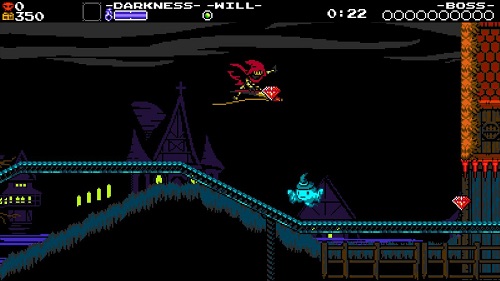
Nothing is without its flaws, however, and there are a couple things that are lacking from Specter of Torment. There are no bonus stages to test your skill with the various subweapons (called Curios in this game), in their place are teeny-tiny training stages that are roubt two screens long. Not a great alternative. The Hall of Champions is completely absent, you can’t visit either of the regular towns, and the Troupple King only makes a token appearance in the credits. The optional fights against Baz and Mr. Hat are gone, but you do get to fight Shield Knight, which is unique to Specter Knight’s game. There is also only one Tower of Fate stage instead of two, which is somewhat understandable, because your base is the Tower of Fate. Even the one is kind of stretching. Otherwise, everything is pretty well accounted for, with some degree of novelty added to it.
Specter Knight’s arsenal is a bit of a mixed bag. Like the other two heroes, he has a number of palette-swap costumes that offer new abilities. And as with the other two heroes, I immediately bought the one that looks fancy but is mechanically the same as the default, and completely ignored the rest. The Curios are all cool, and I can see most of them having a use, but I mostly just had the one that heals you equipped at all times, swapping out for the boomerang scythe when I needed a little extra range and the reaper claw to take out those stupid green fan guys in one shot. I wanted to find a reason to use the mirror that gives you a Ninja Gaiden-eque shadow double, but it never seemed overly helpful for the amount of Darkness (MP) it used up. What is really neat is that each Curio can be upgraded to either increase its power and/or give it a secondary function. Though again, I found myself in a nice groove and not feeling the need to experiment more. So the lack of excitement for all the different Curios is on me, not the game.
While the non-critical stages are missing from Specter of Torment, there are a few extra “flashback” stages that happen for every so many Knights you defeat. These stages tell the backstory of who Specter Knight was in life, why he came to the Tower of Fate in the first place, and how he ended up dying and serving the Enchantress. It’s a neat twist, though these stages aren’t very long and they don’t require mastery of Specter’s Curios. In fact, since they take place in the past, you don’t even get to use the Curios there. But the story is good enough to earn their place, and when past and present meet in the climax, it all comes to a bittersweet ending. I mean, obviously. Spectre Knight isn’t going to somehow end up a good guy and tear apart the time-space continuum. But he’s a tragic character who you probably will feel for at the end.
Once you finally beat the game, if you’ve collected all the Red Skulls (which you trade in for Curios), you can unlock the final costume and subweapon, which are pretty neat. I’d be lying if I said I wasn’t a little disappointed, though. The best unlockable feature would be the ability to play through the Shovel/Plague version of the game as Spectre Knight. Just to see how broken it would be, and in which way. Or maybe vice-versa, but I know that there are several pits that require chaining multiple dash-slashes to get across, and the other two Knights just have no way of crossing that kind of gap. So it’s just not meant to be!
Spectre of Torment comes with new achievements feats and challenge mode stages, which were expected. I haven’t really checked them out yet, but I didn’t notice a feat for clearing the game in such-and-such amount of time, which I think gives credence to my theory that the game was tailor-made for speedrunning. It also comes packaged with the incredibly inclusive Body Swap mode, wherein you can change the gender of any of the main characters and even whether they are assigned male or female pronouns, and once you turn it on you can tweak any of the settings at any time. It’s really much more in-depth than simply flipping everyone’s gender, and for that I applaud Yacht Club Games for their noble efforts. I should also mention that the gender-swapped designs are all incredibly well-thoughtful and sensitive. They didn’t just throw boobs on all the Order Knights and call it a day. In fact, an untrained eye probably wouldn’t even notice the difference between the male and female Shovel Knight sprites. There’s a really great read on the topic of how the characters were redesigned here, and I definitely recommend checking it out. After you’re done reading this, of course.
I should also make it clear that while the Body Swap mode launched in the same update as Specter of Torment, it can only be used with the original Shovel Knight campaign for now. Too bad!
Overall, Specter of Torment is a stellar new game, and an absolutely worthy follow-up to Shovel Knight. I thought it would be nearly impossible to make another campaign as fun and Plague of Shadows, but clearly Yacht Club Games was up to the challenge. I still wonder how in the heck they plan to top this one with a friggin’ King Knight game, but that’s who the people voted for. It’ll certainly be interesting to see how it all rolls out. That’s still at least a year away, so there’s no much point in thinking about it too hard right now. The really fun thing to ponder about it what Yacht Club Games is going to do after all the Shovel Knight DLC is done. I’m sure they’re looking forward to moving onto a new project after spending so many years on the franchise, but it’s been hugely successful for them. Will they dive right into Shovel Knight 2, or try their hands at something completely different? Only time will tell, and they’ve set a very high bar for themselves, but I have every confidence that whatever it is will be awesome.
